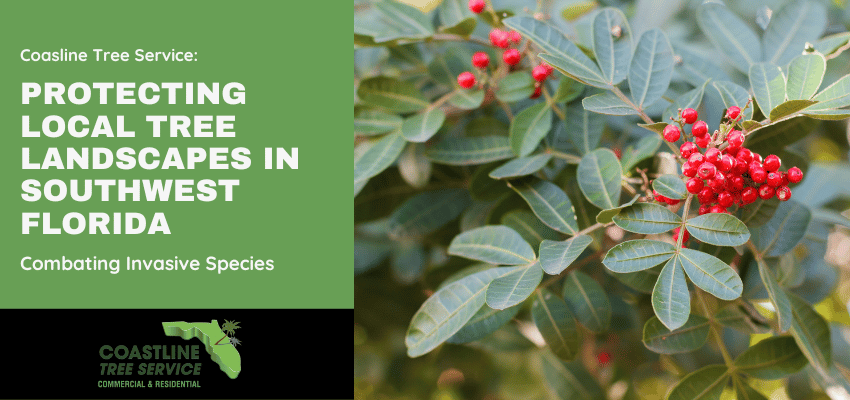
Combating Invasive Species: Protecting Local Tree Landscapes in Southwest Florida
As residents of Southwest Florida, we are graced with lush landscapes and a vibrant array of native flora that contribute to our region’s unique ecological tapestry. However, our native tree populations face significant threats from invasive species that can outcompete, displace, and even eradicate local plants. At Coastline Tree Service, we are committed to raising awareness and providing solutions to combat these intruders, ensuring our local ecosystems remain healthy for generations to come.
In 2024, five invasive species have been identified as particularly harmful to Southwest Florida’s tree populations. Let’s delve deeper into each, exploring their characteristics, spread, impact, and how we can effectively manage and eradicate them.
1. Brazilian Pepper Tree (Schinus terebinthifolia)
Characteristics and Spread: The Brazilian pepper tree is a dense, fast-growing shrub or small tree that can reach up to 30 feet in height. Recognizable by its bright red berries and glossy leaves, this species spreads aggressively through seed dispersal by birds and mammals.
Impact: It forms dense thickets that shade out native plants, reducing biodiversity and altering habitats. Its allelopathic properties inhibit the growth of surrounding vegetation, further exacerbating its dominance in invaded areas.
Management Techniques: Effective management involves a combination of mechanical removal and chemical treatments. Cut-stump herbicide applications are particularly effective, as they prevent resprouting. For a more sustainable approach, introducing natural predators and promoting the growth of native species can help re-establish natural balance.
2. Melaleuca Tree (Melaleuca quinquenervia)
Characteristics and Spread: Often referred to as the ‘paperbark tree,’ Melaleuca is a tall, evergreen tree with a distinctive peeling bark. Originally introduced for landscaping, it quickly invades wetlands, displacing native flora.
Impact: Its dense stands dry out wetlands, increase fire risks, and drastically alter local ecosystems, negatively affecting both plant and animal species.
Management Techniques: The use of biological control agents, such as the Melaleuca weevil and psyllid, has shown success in reducing populations. Mechanical removal combined with herbicide treatments is also effective, though care must be taken to avoid harming non-target species.
3. Australian Pine (Casuarina spp.)
Characteristics and Spread: The Australian pine, with its tall, wispy appearance, is actually not a pine but a flowering plant. It propagates rapidly along coastlines and disturbed areas, primarily through wind and water-dispersed seeds.
Impact: It alters soil chemistry and structure, making it inhospitable for native plants. Its dense canopy blocks sunlight, preventing the growth of understory vegetation.
Management Techniques: Physical removal is the most effective method, though it can be labor-intensive. Follow-up treatments with approved herbicides are necessary to prevent resprouting. Restoration of native plants is crucial to restoring ecosystem function.
4. Old World Climbing Fern (Lygodium microphyllum)
Characteristics and Spread: This climbing vine can reach heights of over 90 feet, smothering trees and shrubs in its path. It spreads through wind-dispersed spores, making it particularly challenging to control.
Impact: The fern forms dense mats that block sunlight and restrict air movement, leading to the decline of native species and increased fire hazards.
Management Techniques: An integrated approach combining mechanical removal, prescribed burns, and targeted herbicide application has proven effective. Manual removal should be conducted with caution to prevent spore dispersal.
5. Chinese Tallow Tree (Triadica sebifera)
Characteristics and Spread: Also known as the popcorn tree, this species is easily identified by its heart-shaped leaves and white, waxy seeds. It thrives in a variety of environments, spreading rapidly through prolific seed production.
Impact: Chinese tallow trees form monocultures that outcompete native vegetation, reducing biodiversity and altering soil conditions.
Management Techniques: Early detection and removal are key to preventing large-scale invasions. Girdling and herbicide treatments are effective for larger trees, while seedlings can be hand-pulled to prevent establishment.
Partner With Coastline Tree Service
At Coastline Tree Service, we are dedicated to providing sustainable solutions and collaborating with the community to safeguard our environment. Together, we can combat these challenges and ensure a flourishing future for our native landscapes.
We proudly serve and offer Tree Landscape & Management Services in Naples, Marco Island, Bonita Springs, Estero, Fort Myers, Fort Myers Beach, North Fort Myers, Cape Coral, Sanibel & Punta Gorda.
Contact us today to schedule your tree inspection at: (239) 895-3230 or contact us online at: https://www.coastlinetree.com/contact-us/
